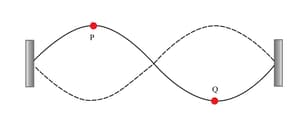K A Tsokos Solutions for Chapter: Waves, Exercise 5: Test yourself
K A Tsokos Physics Solutions for Exercise - K A Tsokos Solutions for Chapter: Waves, Exercise 5: Test yourself
Attempt the practice questions on Chapter 4: Waves, Exercise 5: Test yourself with hints and solutions to strengthen your understanding. Physics for the IB Diploma 6th Edition solutions are prepared by Experienced Embibe Experts.
Questions from K A Tsokos Solutions for Chapter: Waves, Exercise 5: Test yourself with Hints & Solutions
A pipe with both ends open has two consecutive harmonics of frequency and . Determine the length of the pipe. (Take the speed of sound to be .
A pipe with both ends open and a pipe with one open and one closed end have the same frequency in the first harmonic. Calculate the ratio of the length of the pipe to that of pipe.
If you walk at one step a second holding a cup of water (diameter ) the water will spill out of the cup. Use this information to estimate the speed of the waves in water.
Consider a string with both ends fixed. A standing wave in the second harmonic mode is established on the string, as shown in the diagram. The speed of wave is .

Consider the vibrations of two points on the string, P and Q. The displacement of point P is given by the equation where in and is in seconds. Calculate the length of the string.
Consider a string with both ends fixed. A standing wave in the second harmonic mode is established on the string, as shown in the diagram. 
Consider the vibrations of two points on the string, P and Q. The displacement of point P is given by the equation where in and is in seconds. State the phase difference between the oscillation of point P and that of point Q. Hence write down the equation giving the displacement of point Q.
A horizontal aluminium rod of length is hit sharply with a hammer. The hammer rebounds from the rod later. Explain why the hammer rebounds.
A horizontal aluminium rod of length is hit sharply with a hammer. The hammer rebounds from the rod later. Calculate the speed of sound in aluminium.
A horizontal aluminium rod of length is hit sharply with a hammer. The hammer rebounds from the rod later. Calculate the speed of sound in aluminium. The hammer created a longitudinal standing wave in the rod. Estimate the frequency of the sound wave by assuming that the rod vibrates in the first harmonic.
